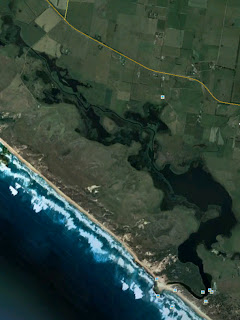To curb my depressed state I had hatched a plot for an alternative birding adventure by dropping in to the Port Campbell National Park. This would make the 4 hour trip a day-long venture!
The attraction was partly renewing acquaintance with a stretch of coast close to my heart and also that I recalled coming across Singing honeyeater readily (pre-birding days). However the clincher was comments contained in tourist promotional brochures such as this:
The endangered rufous bristle bird is technically abundant in the protected coastal heath of our National and Coastal parks. Ardent twitchers that have often waited a long time to see the birds are often disappointed when directed to the car park at Loch Ard Gorge for an almost guaranteed sighting.
The cocky birds put on quite a show fluffing their rust colored crest twitching their tails and doing a fair impression of the roadrunner darting across the car park.
Can anyone not guess what comes next?
Eremaea data boasted a 100% strike rate for Rufous bristlebird for Loch Ard Gorge ..... before our visit. We gave it a good chance at The 12 Apostles, Loch Ard Gorge, London Bridge and Bay of Martyrs. Admittedly it was the middle of the day..... mid afternoon ....... late afternoon.
Anyway we have learnt a lot about bristlebird, did enjoy the scenery and had good views of Singing honeyeater (of course, they were all over the place Port Fairy - please don't tell the missus).
....and did you know that by adding another half hour to the detour above you can take in the Ralph Illidge Sanctuary "one of the most reliable places in Victoria to see Grey (White) Goshawk".
How could I resist?































